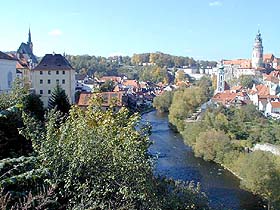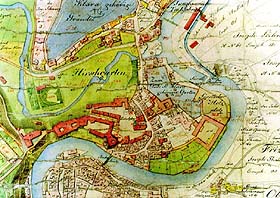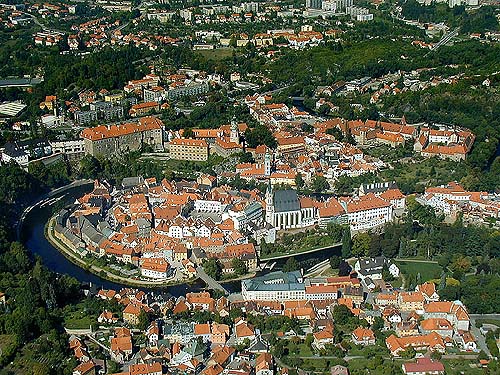Historical gardens and parks in Český Krumlov
 During the last decade,
the historical town of Český Krumlov with its vast castle residence
has attracted the attention of hundreds of thousands of tourists,
but stands nonetheless at the forefront of cultural and
professional public view. The extraordinary value of Český Krumlov
was stressed by UNESCO when it was included on its List of World
Cultural and Natural Heritage in 1992. In Český Krumlov's case,
the primary reason for its classification in this prestigious list
was not the artistic value of the individual monuments or works of
art it holds preserved, but first and foremost the unique
harmonious visual impression the historical seat gives with its
extraordinarily valuable relief landscape. A distinctive element in
the cultural landscape of Český Krumlov is the historical gardens
situated within the grounds of the castle as well as in the town
itself. The Český Krumlov collection of historical seigniorial,
ecclesiastical and municipal gardens and parks is, as far as the
abundance of types is concerned, comparable with other significant
residential towns in the Czech and Moravian lands, for instance
with the Kroměříž gardens and to a certain extent even with the
Prague gardens. The artistically most valuable of the Český Krumlov
gardens have always been the seigniorial gardens; of these, the
most significant is the castle garden. In the shade of the castle
garden lay a series of further valuable historically evolved
gardens.
During the last decade,
the historical town of Český Krumlov with its vast castle residence
has attracted the attention of hundreds of thousands of tourists,
but stands nonetheless at the forefront of cultural and
professional public view. The extraordinary value of Český Krumlov
was stressed by UNESCO when it was included on its List of World
Cultural and Natural Heritage in 1992. In Český Krumlov's case,
the primary reason for its classification in this prestigious list
was not the artistic value of the individual monuments or works of
art it holds preserved, but first and foremost the unique
harmonious visual impression the historical seat gives with its
extraordinarily valuable relief landscape. A distinctive element in
the cultural landscape of Český Krumlov is the historical gardens
situated within the grounds of the castle as well as in the town
itself. The Český Krumlov collection of historical seigniorial,
ecclesiastical and municipal gardens and parks is, as far as the
abundance of types is concerned, comparable with other significant
residential towns in the Czech and Moravian lands, for instance
with the Kroměříž gardens and to a certain extent even with the
Prague gardens. The artistically most valuable of the Český Krumlov
gardens have always been the seigniorial gardens; of these, the
most significant is the castle garden. In the shade of the castle
garden lay a series of further valuable historically evolved
gardens.
The landscape setting of the town of Český
Krumlov
The unique urbanistic structure of the town of Český Krumlov is
conditioned primarily by the landscape relief. The appearance of
the landscape is provided by the geologic construction, but of
course also by the processes and evolutions which the region
encountered during its geologic history, mainly during the period
at the turn between the Tertiary and Quarternary.
In the morphology of the Český Krumlov town landscape, the meandering and deeply engraved Vltava valley makes an expressive mark with steep, often craggy slopes, as do the valleys of the Vltava affluents. In contrast with these lowly situated areas, we are greeted with the surrounding hills of the landscape with hillocks, mainly with the dominating highest point of the Blanský woods - the mountain Kleť (1084 m).
 Regarding the position of
the medieval parts of the town at the level where the Vltava River
meanders (with the exception of the block of buildings around the
church on today's Horní street), the surrounding landscape, in
medieval times being mainly agricultural, entered in close contact
with the interior of the medieval built-up area. >From the
visual perspective of the town square, from the bridge, and often
at the end of the town streets as well, the first horizon to appear
was mainly the silhouettes of the fitful craggy banks of the river
Vltava, covered with a woody vegetation. Across these slopes, on
the surfaces of the originally Tertiary river terraces, was less
slopy land found and intensively exploited for agriculture. The
second dominant features of the town landscape, further off but
nonetheless very important, were formed by the rise of Křížová
(Cross) hill, spot height 562,2 north-east from Domoradice, the
silhouette of the Liščí mountains, the Městský peak, Ptačí hrádek,
and Dubík. The third horizon of the landscape in the Český Krumlov
surroundings is dominated by the massif of the Blanský woods with
its peak Kleť mountain to the North, to the north-east the
silhouette of the Věncové mountains and to the South the Vraní
hill.
Regarding the position of
the medieval parts of the town at the level where the Vltava River
meanders (with the exception of the block of buildings around the
church on today's Horní street), the surrounding landscape, in
medieval times being mainly agricultural, entered in close contact
with the interior of the medieval built-up area. >From the
visual perspective of the town square, from the bridge, and often
at the end of the town streets as well, the first horizon to appear
was mainly the silhouettes of the fitful craggy banks of the river
Vltava, covered with a woody vegetation. Across these slopes, on
the surfaces of the originally Tertiary river terraces, was less
slopy land found and intensively exploited for agriculture. The
second dominant features of the town landscape, further off but
nonetheless very important, were formed by the rise of Křížová
(Cross) hill, spot height 562,2 north-east from Domoradice, the
silhouette of the Liščí mountains, the Městský peak, Ptačí hrádek,
and Dubík. The third horizon of the landscape in the Český Krumlov
surroundings is dominated by the massif of the Blanský woods with
its peak Kleť mountain to the North, to the north-east the
silhouette of the Věncové mountains and to the South the Vraní
hill.
Further information:
- The historical evolution of Český Krumlov gardens and parks in the 14th and 15th centuries (Gothic period)
- The historical evolution of Český Krumlov gardens and parks in the reign of the last Rosenbergs (Renaissance and Mannerism period)
- The historical evolution of Český Krumlov gardens and parks under the administration of the emperor in the years 1601 - 1622 (Mannerism period)
- The historical evolution of Český Krumlov gardens and parks in the period of the reign of the princes of Eggenberg in the years 1622 - 1719 (Mannerism period and the beginnings of the Baroque)
- The historical evolution of Český Krumlov gardens and parks in the reign of the first two generations of the princes of Schwarzenberg in the years 1719 - 1782 (Baroque and Rococo period)
- The historical evolution of Český Krumlov gardens and parks in the years 1782 - 1850 (Classic and Romantic period)
- The historical evolution of Český Krumlov gardens and parks in the years 1850 - 1939 (Historic period and modern times)
- The historical evolution of Český Krumlov gardens and parks from the year 1939 to the present


